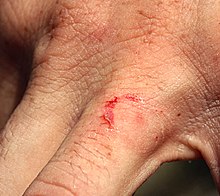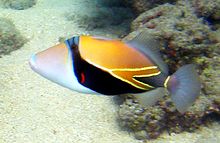| Revision as of 18:26, 20 April 2014 editRjwilmsi (talk | contribs)Extended confirmed users, Pending changes reviewers, Rollbackers932,006 editsm →Spawning and biparental care: Added 1 dois to journal cites using AWB (10081)← Previous edit | Revision as of 01:05, 25 July 2014 edit undoMonkbot (talk | contribs)Bots3,695,952 editsm →Male territoriality: Task 5: Fix CS1 deprecated coauthor parameter errorsNext edit → | ||
| Line 50: | Line 50: | ||
| ===Male territoriality=== | ===Male territoriality=== | ||
| Triggerfish males migrate to their traditional spawning sites prior to mating and establish territories. Some male species (i.e.'' ]'' and '']'') build hollow nests within their territories.<ref>{{cite journal|last=Lobel|first=Phillip| |
Triggerfish males migrate to their traditional spawning sites prior to mating and establish territories. Some male species (i.e.'' ]'' and '']'') build hollow nests within their territories.<ref>{{cite journal|last=Lobel|first=Phillip|author2=Robert E. Johannes |title=Nesting, egg and larvae of triggerfish (Balistidae).|journal=Environmental Biology of Fishes|year=1980|volume=3|issue=2|page=251-252}}</ref> Triggerfish males are fierce in guarding their territories as having a territory is essential for reproduction. A male's territory is used for spawning and parental care. Most male territories are located over a sandy sea bottom or on a rocky reef. A single territory usually includes more than one female, and the male mates with all of the females residing in or visiting his territory ('']''). In Hachijojima, ], Japan, one male crosshatch triggerfish ('']'') has up to three females in his territory at the same time, and mates with them in pairs. Each male red-toothed triggerfish ('']'') mates with more than ten females in his territory on the same day.<ref name=":6">{{cite journal|last=Kawase|first=Hiroshi|title=Spawning behavior and biparental egg care of the crosshatch triggerfish, Xanthichthys mento (Balistidae).|journal=Environmental Biology of Fishes|year=2003|volume=66|page=211-219}}</ref> Yellow margin triggerfish ('']'') also exhibit polygyny mating. | ||
| ===Spawning and biparental care=== | ===Spawning and biparental care=== | ||
Revision as of 01:05, 25 July 2014
For the surveillance technology, see Triggerfish (surveillance).
| Triggerfish Temporal range: Miocene - recent | |
|---|---|

| |
| Picasso triggerfish (Rhinecanthus aculeatus) | |
| Scientific classification | |
| Kingdom: | Animalia |
| Phylum: | Chordata |
| Class: | Actinopterygii |
| Order: | Tetraodontiformes |
| Family: | Balistidae A. Risso, 1810 |
| Genera | |
|
Abalistes | |
Triggerfishes are about 40 species of often brightly colored fishes of the family Balistidae. Often marked by lines and spots, they inhabit tropical and subtropical oceans throughout the world, with the greatest species richness in the Indo-Pacific. Most are found in relatively shallow, coastal habitats, especially at coral reefs, but a few, such as the aptly named oceanic triggerfish (Canthidermis maculata), are pelagic. While several species from this family are popular in the marine aquarium trade, they are often notoriously ill-tempered.
Anatomy and appearance

The largest member of the family, the stone triggerfish (Pseudobalistes naufragium) reaches 1 metre (3.3 ft), but most species have a maximum length between 20 and 50 centimetres (7.9 and 19.7 in).
Triggerfish have an oval shaped, highly compressed body. The head is large, terminating in a small but strong- jawed mouth with teeth adapted for crushing shells. The eyes are small, set far back from the mouth, at the top of the head. The anterior dorsal fin is reduced to a set of three spines. The first spine is stout and by far the longest. All three are normally retracted into a groove. The anal and posterior dorsal fins are capable of undulating from side to side to provide slow speed movement. The sickle shaped caudal fin is used only to escape predators.

The two pelvic fins are overlaid by skin for most of their length and fused to form a single spine, terminated by very short rays, their only external evidence. Gill plates operculum too, although present are not visible, overlaid by the tough skin, covered with rough, rhomboid scales, that forms a stout armor on their body. The only gill opening is a vertical slit, directly above the pectoral fins. This peculiar covering of the gill plates is shared with other members of the Tetradontae order. Each jaw contains a row of four teeth on either side, while the upper jaw contains an additional set of six plate-like pharingeal teeth.
As a protection against predators, triggerfish can erect the first two dorsal spines: The first, (anterior) spine is locked in place by erection of the short second spine, and can be unlocked only by depressing the second, “trigger” spine, hence the family name “triggerfish”.
With the exception of a few species from the genus Xanthichthys, the sexes of all species in this family are similar in appearance.
Behavior

The rather bizarre anatomy of the triggerfishes reflects their typical diet of slow-moving, bottom dwelling crustaceans, mollusks, sea urchins and other echinoderms, generally creatures with protective shells and spines. Many will also take small fishes and some, notably the members of the genus Melichthys, feed on algae. A few, for example the redtoothed triggerfish (Odonus niger), mainly feed on plankton. They are known to exhibit a level of intelligence that is unusual among fishes, and have the ability to learn from previous experiences.

Some triggerfish species can be quite aggressive when guarding their eggs. Both the picasso (Rhinecanthus aculeatus) and titan triggerfish (Balistoides viridescens) viciously defend their nests against intruders, including scuba divers and snorkelers. Their territory extends in a cone from the nest toward the surface, so swimming upwards can put a diver further into the fishes' territory; a horizontal swim away from the nest site is best when confronted by an angry triggerfish. Unlike the relatively small picasso triggerfish, the titan triggerfish poses a serious threat to inattentive divers due to its large size and powerful teeth.
Male territoriality
Triggerfish males migrate to their traditional spawning sites prior to mating and establish territories. Some male species (i.e. Balistes carolinensis and Pseudobalistes flavimarginatus) build hollow nests within their territories. Triggerfish males are fierce in guarding their territories as having a territory is essential for reproduction. A male's territory is used for spawning and parental care. Most male territories are located over a sandy sea bottom or on a rocky reef. A single territory usually includes more than one female, and the male mates with all of the females residing in or visiting his territory (polygyny). In Hachijojima, Izu Islands, Japan, one male crosshatch triggerfish (Xanthichthys mento) has up to three females in his territory at the same time, and mates with them in pairs. Each male red-toothed triggerfish (Odonus niger) mates with more than ten females in his territory on the same day. Yellow margin triggerfish (Pseudobalistes flavimarginatus) also exhibit polygyny mating.
Spawning and biparental care
Triggerfish spawning is timed in relation to lunar cycles, tides, and time of changeover of tides. In relation to lunar cycles, eggs are observed 2-6 days before the full moon and 3-5 days before the new moon. In relation to tides, spawning happens 1-5 days before the spring tide. In relation to timing of tides, eggs are observed on days when high tides take place around sunset.
Male and female triggerfish perform certain pre-spawning behaviors: blowing and touching. A male and female blow water on the sandy bottom (usually in the same spot at the same time) and set up their egg site. They touch their abdomens on the bottom as if they are spawning. During actual spawning, eggs are laid on the sandy sea bottom (triggerfish are demersal spawners despite their large size). Eggs are scattered and attached to sand particles. Triggerfish eggs are usually very small (diameter of 0.5-0.6mm) and are easily spread by waves. After spawning, both the male and female participate in caring for the fertilized eggs (biparental egg care). A female triggerfish stays near the spawning ground, around 5 meters off the bottom, and guards the eggs within her territory against intruders. Some common intruders include Parupeneus multifasciatus, Zanclus cornutus, Prionurus scalprum and conspecifics. Besides guarding, females will roll, fan, and blow water on eggs to provide oxygen to the embryo, thereby inducing hatching. This behavior of female triggerfish is called 'tending,' and males rarely perform this behavior. A male triggerfish stays farther above the eggs and guards all the females and eggs in his territory. Males exhibit aggressive behaviors against conspecific males near the boundaries of their territories.
Mating systems
In crosshatch triggerfish (Xanthichthys mento) and yellow margin triggerfish (Pseudobalistes flavimarginatus), eggs are spawned in the morning and they hatch after the sunset on the same day. After hatching of embryos, the female crosshatch triggerfish leaves the male's territory. This mating system is an example of male-territory-visiting polygamy. Triggerfishes exhibit other types of mating systems, as well, such as a nonterritorial-female (NTF) polygyny and territorial-female (TF) polygyny. In NTF polygyny, nonterritorial females stay in the male's territory and reproduce. In TF polygyny, a female owns territory within a male's territory and will spawn in her territory.
Life history

Triggerfish lay their demersal eggs in a small hole dug in the sea bottom. Off Florida, juveniles of some species of triggerfishes are found in floating sargassum, where they feed on the small shrimp, crabs and molluscs found there.
Edibility
Some species of triggerfish, such as the titan triggerfish, may be ciguatoxic and should be avoided. Others, such as the grey triggerfish (Balistes capriscus), are excellent table-fare.




References
- ^ Lieske, E., & R. Myers (1999). Coral Reef Fishes. 2nd edition. Princeton University Press. ISBN 0-691-00481-1
- ^ McDavid, J. (2007). Aquarium Fish: Triggerfish. Advanced Aquarist.
- Froese, Rainer; Pauly, Daniel (eds.). "Pseudobalistes naufragium". FishBase. January 2010 version.
- Debelius, H. (1993). Indian Ocean Tropical Fish Guide. Aquaprint Verlags GmbH. ISBN 3-927991-01-5
- Millington, J. T., & J. E. Randall (1990). Triggerfish bite – a little-known marine hazard. J. Wilderness Medicine 1: 79-85
- Lobel, Phillip; Robert E. Johannes (1980). "Nesting, egg and larvae of triggerfish (Balistidae)". Environmental Biology of Fishes. 3 (2): 251-252.
- ^ Kawase, Hiroshi (2003). "Spawning behavior and biparental egg care of the crosshatch triggerfish, Xanthichthys mento (Balistidae)". Environmental Biology of Fishes. 66: 211-219.
- ^ Gladstone, William (1994). "Lek-like spawning, parental care and mating periodicity of the triggerfish Pseudobalistes flavimarginatus (Balistidae)". Environmental Biology of Fishes. 39: 249-257. doi:10.1007/bf00005127.
- Kawase, Hiroshi (2003). "Maternal egg care in the bridled triggerfish, Sufflamen fraenatus (Balistidae) at Hachijojima island, Japan". Nat His Res. 7: 193-197.
- Reebs, Stephan. "Are fishes good parents?" (PDF).
- Matsura, Keiichi & Tyler, James C. (1998). Paxton, J.R. & Eschmeyer, W.N. (ed.). Encyclopedia of Fishes. San Diego: Academic Press. pp. 228–229. ISBN 0-12-547665-5.
{{cite book}}: CS1 maint: multiple names: authors list (link)
- Froese, Rainer; Pauly, Daniel (eds.). "Family Balistidae". FishBase. February 2011 version.